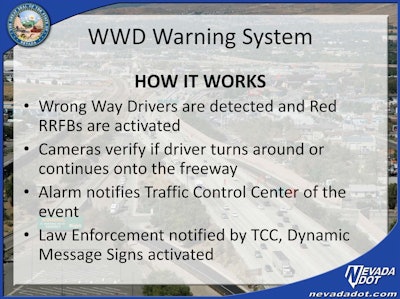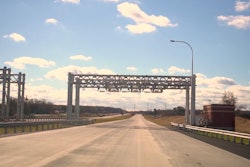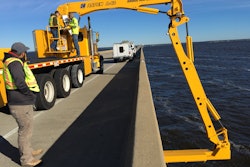 Nevada has been installing and testing a new system for detecting wrong-way drivers. PHOTO: NDOT
Nevada has been installing and testing a new system for detecting wrong-way drivers. PHOTO: NDOTThe Nevada Department of Transportation (NDOT) has begun testing and activating new wrong-way driver detection systems on U.S. 395 as one of a handful of states trying out the technology to stop such crashes, which tend to have higher fatality rates than other crashes.
NDOT currently places “Wrong Way” signs on all freeway ramps to notify drivers errantly entering in the wrong direction.
Now, in its pilot program, NDOT has installed additional flashing warning signals and detection systems on 20 U.S. 395 ramps in the North Valleys. The system uses radar and closed-circuit cameras to automatically detect vehicles entering in the wrong direction, activating two sets of red flashing wrong-way signs on the ramp.
“As a highly-visible additional indication to stop drivers from entering the wrong way, the first set of signs stands four feet high instead of the standard seven-foot sign height to more readily reach the lower eye level of sleepy or impaired drivers,” the department says in a press release.
The Transportation Research Board reports an average of 360 deaths nationwide every year due to wrong-way driver crashes. In more than half of wrong-way crashes, wrong-way drivers are impaired by alcohol, NDOT says.
Between January 1, 2005 and January 1, 2015, there were 409 wrong-way crashes in Nevada resulting in 75 deaths, according to state statistics.
Nevada is one of a handful of state DOTs testing the wrong-way driver detection systems because preliminary research shows that such systems are 80 percent effective in stopping wrong-way drivers. In 2017, the Arizona State Transportation Board approved the installation of a wrong-way vehicle detection and alert system for Interstate 17 in Phoenix that was the first of its kind in the U.S.
That $3.7 million system is designed to immediately alert ADOT of a wrong-way driver, with the agency alerting drivers through overhead message boards. Thermal cameras positioned one mile apart will signal Arizona State Troopers.
The Nevada detection system is part of an NDOT project to install additional traffic cameras, highway message signs, traffic and weather sensors and more to help keep drivers safer and more informed of road conditions on U.S. 395 from the spaghetti bowl north to the Nevada-California state line.
Individual freeway ramps have been intermittently be closed for up to four hours weeknights between 9 p.m. and 5 a.m. from Jan. 8 through about Jan. 15. No two consecutive ramps will be closed at the same time, the department says. During those closures, signs will route motorists to detour via the nearest interchange.













